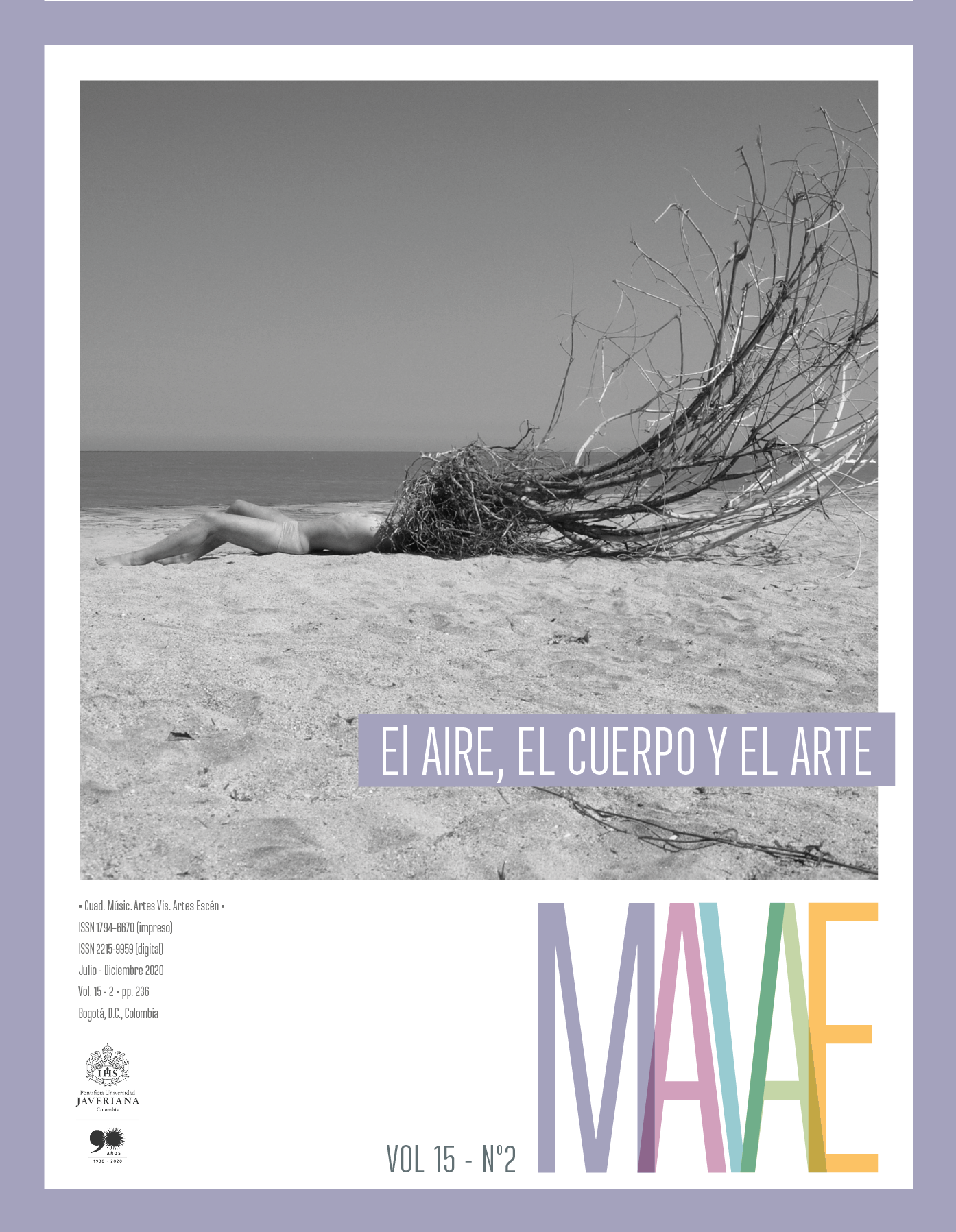Resumo
Uma das principais funções do sistema respiratório é respirar e, embora essa afirmação pareça óbvia e risível, eu gostaria de perguntar, o que acontece quando o sistema respiratório não usa ar para respirar? Diante dessa incógnita, decidiu-se realizar duas pesquisas — a primeira com base na ciência forense e a segunda a partir das artes vivas — para investigar a função do sistema respiratório. Ao preparar este artigo, era de vital importância trabalhar com o Dr. Jorge Franco e a Dra. Michelle Cortés, do Departamento de Morfologia da Pontifícia Universidad Javeriana. Ao contrastar a causa da morte examinada no cadáver encontrado no ambiente aquático, com os sintomas respiratórios analisados nos artistas, verificou-se que o ar não parece tão óbvio em suas qualidades gasosas e respiratórias que apresenta. Às vezes, a falta de ar é mais do que tentar preenchê-lo, outras vezes, o ar é insuficiente para dizer o que pensamos. Em muitas ocasiões, não prestamos atenção à importância de usar o ar para respirar, justamente porque achamos fácil viajar por esse ambiente quase imperceptível e inato da condição humana.
2019. https://www.betweenmusic.dk/about.
Burden, Chris. 1975. Doomed. Chicago: Museo de Arte Contemporáneo
de Chicago. https://mcachicago.org/Publications/Blog/2015/5/
In-Support-Of-Uncertainty-Chris-Burdens-Doomed.
Cardona, Jairo. 2014. “¿Por qué la gente se suicida? La otra versión”. Ariel
15: 47-51. http://www.academia.edu/download/35702107/Filosofia_
del_Uruguay__Revista_ARIEL_N_15.pdf#page=47
Concheiro Carro, L. y J. M. Suárez Peñaranda. 2004. “Asfixias mecánicas”.
En Medicina legal y toxicología. 60.ª ed., editado por E. Villanueva,
460-478. Barcelona: Masson.
eju! 2014. “India: Este es el ‘Hombre elefante’ que no puede ser operado”.
Consulta: 6 de agosto de 2019. https://eju.tv/2014/03/india-este-esel-
hombre-elefante-que-no-puede-ser-operado/
ELF (European Lung Fundation). 2019. “Los pulmones y el ejercicio”.
Consulta: 20 de septiembre de 2019. https://www.europeanlung.org/
assets/files/es/publications/lungs-and-exercise-es.pdf.
Espinosa Tapias, Juanita. 2019. “Llamado de origen”. Tesis de grado,
Pontificia Universidad Javeriana. https://repository.javeriana.edu.co/
handle/10554/44017
Everett Millais, John. 1851-1852. Ophelia. Londres: Tate Britain. https://
www.tate.org.uk/art/artworks/millais-ophelia-n0150
Gómez-Acebo, Isabel. 2007. María Magdalena: De apóstol a prostituta y
amante. Bilbao: Desclée de Brouwer.
González, Claudio. 2014. “Rcp 5 - fisiopatología del ahogado”. Consulta: 2
de noviembre de 2019. https://es.slideshare.net/claudiogonzalezg/
rcp-5-fisiopatologia-del-ahogado.
Guasch, Ana María. 2011. Arte y archivo, 1920-2010: Genealogías, tipologías
y discontinuidades. Madrid: Akal.
Instituto Nacional de Medicina Legal y Ciencias Forenses. 2004. Guía de
procedimientos para la realización de necropsias medicolegales, 2.ª
ed. Bogotá: Instituto Nacional de Medicina Legal y Ciencias Forenses.
shorturl.at/jzFWX
Morcillo Mércedez, María Dolores. 2012. “Cuerpos recuperados del agua”.
Boletín 35. https://prezi.com/ariyjaycadwr/cuerpos-recuperadosen-
el-agua/
Nosworthy, J. M. 1964. “The Death of Ophelia”. Shakespeare Quarterly 15
(4): 345-48. https://doi:10.2307/2868091.
Patiño, José Félix. 1998. Gases sanguíneos, fisiología de la respiración e
insuficiencia respiratoria aguda, 6.ª ed. Bogotá: Editorial Médica
Panamericana.
Real Academia Española. 2014. “Impulso”. En Diccionario de la lengua
española. 23.ª ed. Madrid: Espasa. Consulta: 15 de agosto de 2019.
https://enclave.rae.es/recursos/diccionarios/dle/L9MJRDS.
Rodríguez Gómez, Irene. 2017. “Diálogos somáticos, válvulas sonoras y
otras formas de posesión”. Tesis de maestría, Universidad Nacional
de Colombia. http://bdigital.unal.edu.co/58536/
Roger Ebert. 1975. “Chris Burden: ‘My God, are they going to leave
me here to die?’”, Roger ebert (blog), 25 de mayo. https://www.
rogerebert.com/interviews/chris-burden-my-god-are-they-goingto-
leave-me-here-to-die.
Romero Polanco, José Luis. 2007. “Muertes por sumersión: Revisión y
actualización de un tema clásico de la medicina forense”. Cuadernos
de Medicina Forense 48-49: 99-130. http://scielo.isciii.es/scielo.
php?script=sci_arttext&pid=S1135-76062007000200001
Rosenzvaig, Marcos. 2009. El teatro de la enfermedad. Buenos Aires: Biblos.
Sánchez Prieto, Isabella. 2018. “CNI DE O (cuerpo no identificado de
O)”. Tesis de grado, Pontificia Universidad Javeriana. https://
repository.javeriana.edu.co/handle/10554/35624
Sibón Olano, A., P. Martínez-García, M. A. Vizcaya Rojas y J. L.
Romero Palanco. 2005. “Síndrome de asfixia sumersión”.
Cuadernos de Medicina Forense 41: 229-233. http://scielo.isciii.
es/scielo.php?pid=S1135-76062005000300006&script=sci_
arttext&tlng=en
Shakespeare, Guillermo. 2003. Hamlet. Santiago de Chile: El Cardo.
https://www.biblioteca.org.ar/libros/89485.pdf
Shakespeare, William. 2016. Hamlet. Editado por Ann Thompson y Neil
Taylor. Londres: Bloomsbury.
Shakespeare, William. s. f. Hamlet. Medellín: Bedout.
Sloterdijk, Peter. 2003. Esferas I. Burbujas: Microesferología. Madrid: Siruela.
Tortora, Jerry y Sandra Reynolds. 2002. Principios de anatomía y
fisiología, 9.ª ed. México: Oxford University Press.
Zhou, Chong y Roger W. Byard. 2011. “Factors and Processes Causing
Accelerated Decomposition in Human Cadavers: An Overview”.
Journal of Forensic and Legal Medicine 18 (1): 6-9. https://doi.
org/10.1016/j.jflm.2010.10.003
Noriega, Zoitsa. 2015. Persistir. Bogotá: Espacio Odeón. https://www.
youtube.com/watch?v=WJrD1eV0jTk
Zoitsa Noriega. 2019. “Zoitsa Noriega”. Consulta: 7 de septiembre de
2019. https://www.zoitsanoriega.com/persistir

Este trabalho está licenciado sob uma licença Creative Commons Attribution 4.0 International License.
Copyright (c) 2020 Isabella Sánchez Prieto



